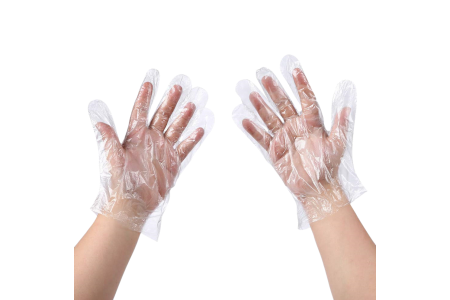Why PE Gloves are the Best Choice for Food Handling
Published on 2023/4/14

Share to:
Why PE Gloves are the Best Choice for Food Handling
PE gloves are the best choice for food handling. They are lightweight and flexible, which provides a high level of dexterity, and they are disposable, which makes them a cost-effective choice for busy kitchens and food service establishments.
When it comes to food handling, safety and hygiene are top priorities. That's why it's crucial to choose the right gloves for the job. While there are many different types of gloves available, polyethylene (PE) gloves are considered the best option for food handling. PE gloves are made from a lightweight and flexible material that provides a high level of dexterity, making them perfect for tasks that require precision and control. Additionally, they are disposable, making them a cost-effective choice for busy kitchens and food service establishments. But the benefits of PE gloves don't stop there. They are also resistant to water and most chemicals, which is important for preventing cross-contamination and reducing the risk of foodborne illness. So, if you're in the food industry, it's time to consider PE gloves for your food handling needs.
What are the Benefits of Using PE Gloves in Food Handling?
PE gloves have several benefits that make them the ideal choice for food handling. Firstly, they are lightweight and flexible, which provides a high level of dexterity. This means that they are easy to put on and take off, and they allow the wearer to handle food with precision and control. Additionally, PE gloves are disposable, which means that they can be easily replaced after each use. This is important for maintaining hygiene and reducing the risk of cross-contamination.
Another benefit of PE gloves is that they are resistant to water and most chemicals. This is important for preventing cross-contamination and reducing the risk of foodborne illness. PE gloves are also easy to clean, which means that they can be used multiple times before they need to be replaced. This is important for reducing waste and saving money.
Comparison between PE Gloves and Other Types of Gloves
While there are many different types of gloves available for food handling, PE gloves are considered the best option. This is because they are lightweight and flexible, which provides a high level of dexterity. They are also disposable, which means that they can be easily replaced after each use. Additionally, PE gloves are resistant to water and most chemicals, which is important for preventing cross-contamination and reducing the risk of foodborne illness.
Other types of gloves that are commonly used for food handling include latex gloves and nitrile gloves. Latex gloves are made from natural rubber and are often used in healthcare settings. However, they can cause allergic reactions in some people, which makes them unsuitable for food handling. Nitrile gloves are made from synthetic rubber and are often used in industrial settings. While they are resistant to chemicals, they are not as flexible as PE gloves, which makes them less suitable for tasks that require precision and control.
Regulations and Standards for Food Handling Gloves
In the food industry, it's important to choose gloves that meet the necessary regulations and standards. The Food and Drug Administration (FDA) has established regulations for food handling gloves, which specify the materials that can be used and the testing requirements that must be met.
According to FDA regulations, food handling gloves must be made from materials that are safe for food contact. Additionally, they must be tested for leaks and defects before they are used. Gloves that fail these tests must be discarded.
It's also important to note that food handling gloves should be changed frequently to maintain hygiene and prevent cross-contamination. Gloves should be changed after handling raw meat, poultry, or seafood, and they should be changed between different tasks, such as handling raw and cooked food.
How to Choose the Right PE Gloves for Food Handling
When choosing PE gloves for food handling, there are several factors to consider. Firstly, it's important to choose gloves that are the right size. Gloves that are too small can be uncomfortable and can tear easily, while gloves that are too large can be difficult to work with and can increase the risk of cross-contamination.
It's also important to choose gloves that are resistant to water and most chemicals. This is important for preventing cross-contamination and reducing the risk of foodborne illness. Additionally, gloves that are textured can provide a better grip, which is important for tasks that require precision and control.
Finally, it's important to choose gloves that are from a reputable supplier. This ensures that the gloves are of high quality and meet the necessary regulations and standards for food handling gloves.
Conclusion
Overall, PE gloves are the best choice for food handling. They are lightweight and flexible, which provides a high level of dexterity, and they are disposable, which makes them a cost-effective choice for busy kitchens and food service establishments. Additionally, they are resistant to water and most chemicals, which is important for preventing cross-contamination and reducing the risk of foodborne illness. When choosing disposable PE gloves, it's important to consider factors such as size, texture, and supplier, to ensure that you choose gloves that meet the necessary regulations and standards for food handling gloves.


 WhatsApp
WhatsApp
Send us your message
You can send an email asking for the price and detailed information of this product. We will reply you as soon as we receive your email